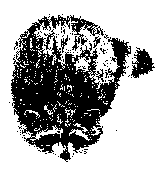
Viral
Diseases in Raccoons 
There are three primary viruses which adversely affect the raccoon population. These are feline distemper, canine distemper and rabies. The rabies virus, even though it is zoonotic (can pass from animal to human) and is of special concern to us when working with these animals, is actually the least complex of these viruses to deal with. All three viruses often reach epizootic proportions due to high population density in the raccoon population.
Susceptibility to infection is related to the absence of antibodies. In the case of the distemper viruses, antibodies passed on by the mother (in the colostrum) will protect young animals for a short period after birth. Active immunity may be obtained by either surviving natural infection or by artificial immunization.
Feline Distemper (feline panleukopenia) is a non-zoonotic animal to animal contact virus. It can be contracted through direct contact or through an animal to object to animal route. In laboratory experiments, the FD virus has withstood temperatures as high as 175 degrees for more than 30 minutes and freezing has little effect. Unlike Canine Distemper, the FD virus doesn't enter the brain of the infected animal. Symptoms are marked by a general depression and anorexia and can include fever, foamy vomiting and bloody diarrhea.
The virus may lay dormant, not affecting the host animal, but intermittently erupting and shedding in its feces, urine, saliva and nasal secretions; sort of a raccoon "Typhoid Mary". However, natural or vaccine produced antibodies will destroy the virus, stopping this shedding process. Antibodies produced by vaccine may last only a few months, but allow time for the animal's natural immune system to take over and produce its own antibodies.
Canine Distemper is a non- zoonotic animal to animal contact and airborne virus. Being airborne, the virus can be infective up to 30 feet away. Canine distemper is highly contagious and is related to the measles virus. Symptoms can include fever, depression anorexia, diarrhea, spasms of the facial or leg muscles, irritated eyes, eye and nasal discharge and convulsions.
As the virus travels through an infected animals' system, symptoms such as eye and nasal discharge and diarrhea can occur. Supportive care can reverse these secondary infections that exist during the early stages. It is after the virus reaches the brain, that we, as rehabilitators, usually see the affected animals. At this point, the raccoon will exhibit neurological and behavioral symptoms such as convulsions, facial spasms, loss of fear of humans and aggression. The raccoons are often out in the daylight hours, appear "tame", are often non-reactive to threat and can be self-mutilating.
If the virus reaches the brain and the animal survives, it will have permanent problems that will greatly reduce its chance of survival in the wild. Chronic CD affects the brain and foot pads, areas that aren't reached by antibodies. In the brain the virus may cause swelling and excruciating pain, a condition called "Old Dog Encephalitis". In the pads of the feet the virus will cause thickening and the pads become hard and painful. The condition is referred to as "Hard Pad Disease", another common name for CD.
Rabies is a zoonotic inoculated virus that shows no outward secondary symptoms as it moves towards the brain. It is not shed in feces, urine, eye or nasal secretions, maternal milk or musk glands. The virus is not carried in the blood, nor does it cross the placental barrier to the fetus. A baby raccoon is not born with rabies, but is exposed at birth by a viral shedding mother as she grooms the newborn.
Once the virus crosses the brain stem, it enters the salivary glands and multiplies. At this point symptoms appear that can include depression, apathy, anorexia, eye & nasal discharge, labored breathing, uncoordination, paralysis, aggression and in general, behavior that seems abnormal.
The viral laced saliva can then be "inoculated" into another animal by biting, or by contaminating open wounds that have bled within 24 hours or by entering exposed mucous membranes, i.e. mouth, nose and eyes.
Unlike FD and CD, the rabies virus is very fragile and easily destroyed by soap, water, sunlight and air. It has no potential to contaminate soil or other objects except during the period when the saliva leaves the mouth and is still wet.
To summarize:
Feline Distemper (FD): A virus transmitted by contact that survives outside the body.
Canine Distemper (CD): A virus transmitted by contact and airborne means that survives outside the body.
Rabies: A virus transmitted by inoculation (transmission of fresh saliva via bites or fresh wounds) that does not survive outside the body